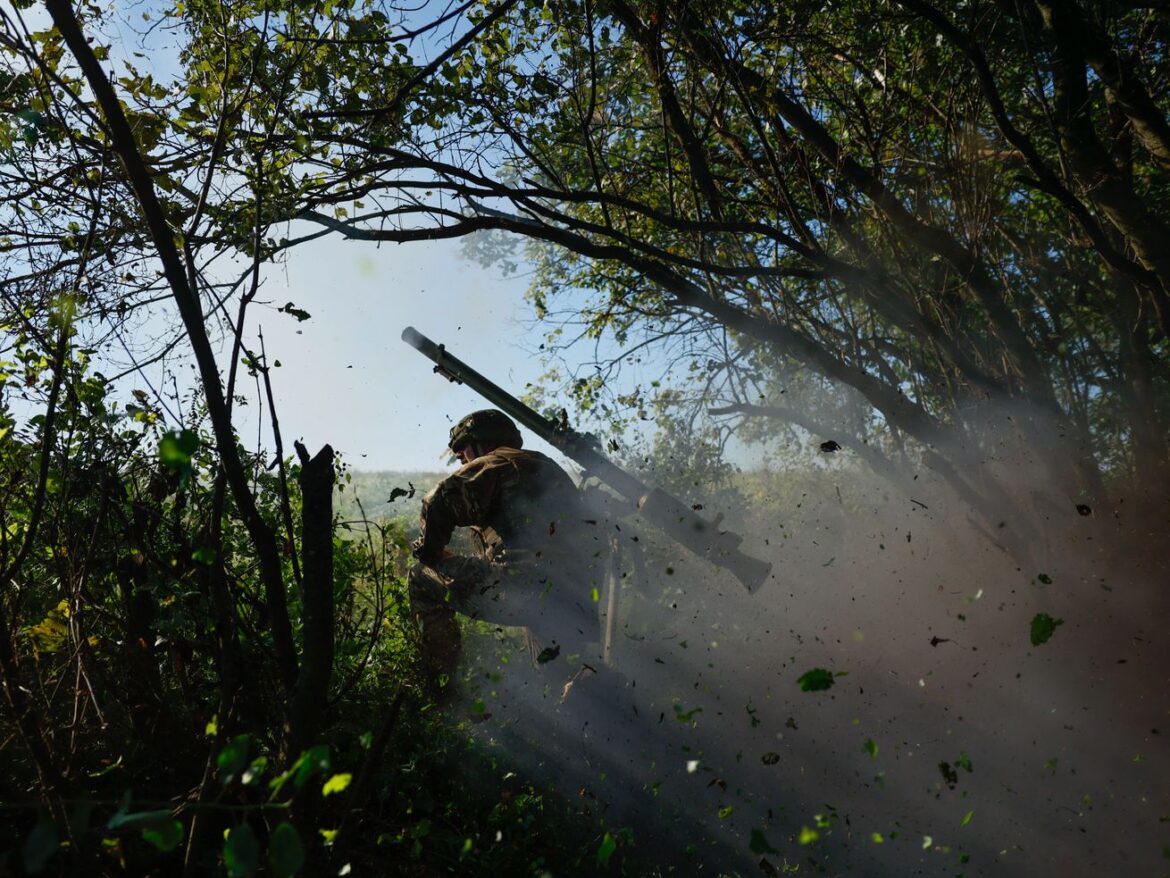Reports of squabbles over the counteroffensive are a reminder that Ukraine and the US aren’t sure what comes after this operation — and if they’ll want the same thing.
At the end of August, Ukraine reportedly breached the first Russian line of defense in the southeast after months of a lumbering counteroffensive fight. This is not the biggie; Russia still has defensive lines behind this one, and it is barraging Ukrainian troops with artillery fire. But it is a sign that Ukraine can still pull off a major breakthrough.
It probably couldn’t have come at a better time.
In recent weeks, rifts have opened up between Ukraine and the United States over the slow pace of Ukraine’s counteroffensive. Both want Ukraine to succeed and to reach its generally understood objective, which would be to slice through Russian-occupied territory in Ukraine’s south and southeast, splitting up Russia’s so-called “land bridge” from Crimea, making it much harder for Moscow to resupply and maintain long-term control of Ukrainian territory.
But Washington and Kyiv have seemed to disagree on how Ukraine can best achieve that and whether it is even possible this year.
These are largely behind-the-scenes debates that have trickled into view, mostly courtesy of anonymous US officials in recent media reports. Those officials have suggested that Ukraine is moving too slowly, or not committing enough troops in the right places, or maybe it should do a better job using all those tanks the West sent over. Ukraine has pushed back against the armchair generaling, saying, in essence, if you want us to fight your way, equip us the way you’d equip yourself, with things like more long-range firepower and jets. Otherwise, we’re the ones doing the fighting.
Everyone is now an expert on how we should fight. A gentle reminder that no one understands this war better than we do. pic.twitter.com/TIwssQjiFh
— Defense of Ukraine (@DefenceU) August 31, 2023
“Criticizing the slow pace of [the] counteroffensive equals … spitting into the face of (the) Ukrainian soldier who sacrifices his life every day, moving forward and liberating one kilometer of Ukrainian soil after another,” Ukrainian Foreign Minister Dmytro Kuleba said last Thursday, according to Reuters.
Publicly, Washington has been steadfast in its support for Ukraine, with officials insisting that the war is not a stalemate and that Ukraine is making progress. US Secretary of State Antony Blinken visited Kyiv this week, where he announced another $1 billion in aid for Ukraine, another drip in the astonishing $43 billion in security assistance the US has provided since Russia’s invasion.
But splits, even if they’re small right now, hint at the complications baked into the relationship between Washington and Ukraine amid Russia’s aggression. Those complications come down to the different stakes between Kyiv and its Western allies.
Ukraine is fighting an existential battle for its survival. It needs to reclaim its territory, but it is also fighting to defeat Russia, to ensure its long-term security. The United States and its allies have continued to support Ukraine, but largely on their own political timelines and their own terms — terms that don’t necessarily mean an outright Russian defeat.
Ukraine, because of its reliance on outside aid, is fighting a war shaped by the West’s decisions and indecisions, although exactly how is much hard to assess, especially in real time. The counteroffensive slog was not unexpected, but the slower it goes, the more urgent the questions of what comes next for Ukraine and who gets the power to decide.
The US is (mostly anonymously) armchair generaling Ukraine’s counteroffensive
Ukraine’s summer counteroffensive has faced setbacks.
Kyiv had Western-made main battle tanks and some fresh NATO-trained recruits, but it struggled in the early days of the counteroffensive to coordinate all this equipment on a large scale on the battlefield against entrenched Russian defenses. As a result, Ukraine lost equipment and suffered heavy casualties.
Kyiv has since recalibrated, favoring a strategy of attrition: trying to degrade Russian defenses rather than blitz through them. Ukraine targets the backbone of Russian operations, things like artillery launchers or logistics hubs, to wear them down.
This approach is more methodical, and it helps preserve manpower, but it is also slow, slow, slow. “This has become a war of tree lines, with shifts in the line often counted in hundreds of meters,” wrote experts Michael Kofman and Rob Lee in a recent commentary in War on the Rocks.
But US officials appear to want Ukraine to pick up the pace and for Ukraine to take more than a few towns as summer turns to fall. According to the Financial Times, US officials have told Ukraine to be less risk-averse and more fully commit their forces in the main line of attack in the south, specifically in the area that would push them toward the Sea of Azov to cut through Russian territory.
There is no actual deadline for the end of the counteroffensive, but late fall into winter is generally seen as the unofficial one. Ukrainian troops will eventually need to rest and reconstitute, and the weather complicates battlefield plans, whether it is the bitter cold or the eventual mud.
There is also the pressure of a political timeline. In the US, the Republican Party is much more split on longer-term aid for Ukraine, and some GOP members in Congress are pushing back on Biden’s latest supplemental aid request, which includes about $20 billion for emergency and humanitarian support for Ukraine. The GOP primary debates have shown this isn’t a universal Republican position, but the Ukraine skeptics may be the loudest. That’s especially true because Donald Trump, the frontrunner, is one of them, and he has previously indicated he would try to strike a deal between Russia and Ukraine (details TBD, of course).
This is unnerving for Kyiv, and also for many of the US’s allies, who have worked together to try to move in lockstep on Ukrainian aid. Europe has its own politics to deal with, too: Support for the war among the EU public has stayed pretty solid, but the continent’s economic and energy challenges persist. All of which is to say, in the US and among its partners, the longevity of unified support for Ukraine is not guaranteed.
The US and some of its allies won’t necessarily come out and say it, but this is the subtext to some of the urgency around Ukraine’s war effort. Kyiv is very much making progress, weakening Russia and putting pressure on their defensive positions. But Ukrainian troops still haven’t yet been able to exploit this and push deep into Russian-held territory. And when you’re the United States, investing billions, incremental progress is a much harder sell to the public than something like, “Look at all this territory Ukraine is winning back.”
Ukraine is not unaware of or immune to these realities. Their public, who are fighting and dying, is approaching two years of a brutal, unforgiving war. Russia’s invasion strangled Ukraine’s economy. The Russian drones and missiles haven’t stopped, and Russia may again seek to target Ukraine’s energy infrastructure as it did last year, to try to demoralize Ukraine’s population.
No one wants this war to end more than Ukraine. But the battlefield realities are, well, the battlefield realities. “You don’t understand the nature of this conflict,” Gen. Valery Zaluzhny, the commander of the Ukrainian armed forces, said in an interaction with the Americans, a US official recounted to the Wall Street Journal, which was reported last month.
The counteroffensive’s struggles have forced Ukraine and the US to face the future — and maybe they don’t agree on what that is
For Ukraine, the nature of the conflict has always been to reclaim its borders and guarantee a Russian defeat so Moscow cannot invade again. Whether that is an achievable goal is one question. The other question is whether the US — and, by extension, the West — share it.
The United States has repeatedly cited its “steadfast commitment to Ukraine’s sovereignty and territorial integrity” and has said it seeks to ensure “the existence of a free, prosperous and democratic Ukraine that can defend itself and deter further Russian aggression.” President Joe Biden has said there is “no possibility” Russia will win this war.
“I think our aim is to make sure that Russia does not win,” said John Herbst, former US ambassador to Ukraine and senior director of the Atlantic Council’s Eurasia Center. But as he pointed out: Russia not winning is “not the same as Russia losing or Ukraine winning.”
The US has committed itself to making sure Russia does not win and Ukraine does not lose, and it has put extraordinary effort into achieving that: providing massive amounts of assistance and probably some well-timed intelligence, as well as rallying allies and partners to do the same, in Europe and NATO but also beyond.
But the US has also been deliberate in its approach toward Ukraine. The Biden administration has been careful about delivering Ukraine weapons that would allow it to strike directly into Russian territory, out of an effort to avoid escalation. The US and its European allies have often very publicly debated what kind of weapons to donate to Ukraine, and once they make a decision — yes, we’ll send the tanks — it takes time to service, train, and deliver that equipment. The US announced in January it would deliver 31 Abrams tanks. They are reportedly not in battle yet, expected to arrive in Ukraine in mid-September.
In funding, and in some ways fueling, a war, caution is warranted, especially if you’re the US and NATO, operating on the outskirts of a war with a nuclear-armed Russia.
But it also looks very different if you’re Ukraine, a big swath of your country is occupied by an enemy, and your cities are being bombarded by drones and missiles. You want everything you can get to win, all at once. The tanks, the F-16s, the long-range missiles, all of it, now.
It’s impossible to prove whether these tools could have made a difference on the battlefield, and plenty of experts have argued against it, at least in the short term. But the short term is really the problem here.
The realities of the counteroffensive have proved that this is not a war that can be decided in a matter of months, maybe not even years. That has both Ukraine and the US trying to figure out what that means and what the strategic objectives will be for supporting Kyiv this year and next, and maybe next. Is it a long-haul investment in a Ukrainian victory? Is it a weakening of Russia? Or something else?
Ukraine also likely understands that Western support has always been predicated on Ukraine proving itself — that is, Kyiv has to show it can win on the battlefield. Only after that does the Western aid they’ve been asking for come.
Petro Burkovskiy, executive director of Ilko Kucheriv Democratic Initiatives Foundation (DIF), a Ukraine-based think tank, said that has increased distrust between the US and Ukraine. The US withholding aid looks like a way to escape a Russian defeat or weaken Russia in a protracted struggle. “The question is, why? Why are they afraid of delivering the decisive blow?” Burkovskiy asked.
Ukraine, he suggested, does not need its Western backers to attack Russia’s “centers of gravity,” such as Russian aircraft or its Black Sea Fleet. “This can be done without the Western supplies. We have now demonstrated we can do this without Western interference, and we will continue to do this,” he said. “And there will be more independent decision-making.” Only when the US decides it wants to deliver a decisive blow to Russia, he said, will Ukraine and the US be fully in sync.
Ukraine’s drone strikes into Moscow and attacks in Crimea show Kyiv is developing its own capabilities and fighting power. That will not eliminate the need for US and Western aid, but it is, partly, an insurance policy for whatever comes next.



